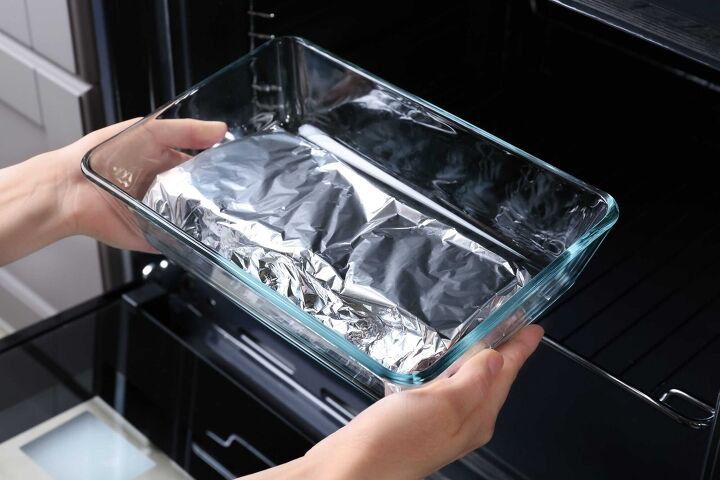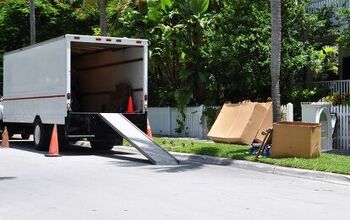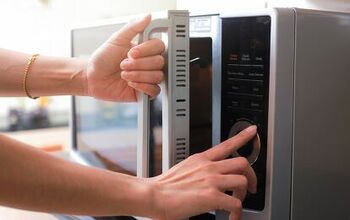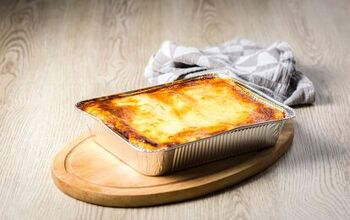Can You Use Aluminum Foil In A Convection Oven?

For baking enthusiasts, convection ovens are a very popular oven choice. They offer the opportunity to bake multiple items at once in a reasonably short time. At one point or another, you may find yourself wondering: “Can you use aluminum foil in a convection oven?”
While this may seem like an odd question, aluminum foil is not suitable for every application. In general, aluminum foil is a very versatile and essential kitchen material to have. Many recipes recommend wrapping or covering food in aluminum foil as it cooks in your oven.
It is safe to put aluminum foil in a convection oven if you wrap your food with it. Never use aluminum foil as an oven liner in a convection oven as that can be dangerous. Aluminum foil is heat resistant but not heatproof, and it is not a sustainable oven liner.
Do You Need Appliance Installation or Replacement?
Get free, zero-commitment quotes from pro contractors near you.

What is a Convection Oven?
What sets convection ovens apart from regular ovens is their fan and exhaust system. The fan and exhaust help to blow the hot oven air over and around the food and then allow it to escape back out. The hot air surrounding the food during cooking results in food that cooks faster and more evenly.
If your oven has a convection setting, you may want to use it for any of the following reasons.
- Food is cooked more evenly. In regular ovens, depending on where the heating element is, they can have hot spots. With a convection oven, the fan will help to circulate the heat to even out the temperature inconsistencies.
- Food cooks faster. As opposed to hot air just surrounding your food, it is blowing directly onto it. This results in food being cooked 25 percent faster in a convection oven than a regular oven.
- Convection saves energy. In a convection oven, the food cooks faster and generally at a lower temperature. This allows it to be slightly more energy efficient than regular ovens.
- Better at browning. In a regular oven, moisture does not have the ability to escape through an exhaust system. This can cause the air in the oven to become humid. However, in convection ovens a dry atmosphere is created and will caramelize sugars faster and more effectively. Interiors of meat and vegetables will stay moist and have a wonderful outer brown coating.
Can You Use Aluminum Foil in a Microwave Convection Oven?
It’s important to note the difference between a convection oven and a microwave convection oven. A microwave convection oven is a combination of a convection oven and a conventional microwave.
They cook faster than microwaves and are suitable for roasting, baking and reheating. Although it’s safe to use aluminum foil during convection cooking in a microwave convection oven, it should never be used when microwaving.
If used to cover or wrap food during microwaving, aluminum foil will prevent the waves from reaching your food, leaving it undercooked. Additionally, it is a major fire hazard when used in microwaves and can cause the inside to overheat and may result in arcing.
Follow these general guidelines when using aluminum foil during convection cooking in your microwave convection oven:
- Only use aluminum foil to shield portions of the food. For example, cover only the leg tips or wings of a chicken to prevent overcooking.
- Use only a small amount of aluminum foil in your microwave convection oven.
- Press the foil as closely as possible to the food item you are cooking.
- Make sure that no piece of the aluminum foil is sticking upward, outward, or away from your food. Otherwise, the foil that is positioned away from the food will act as an antenna and result in arcing in your oven.
When Can I Use Aluminum Foil in a Convection Oven?
Aluminum foil’s versatility and resistance to heat makes it a great option for baking or cooking in a convection oven. Use aluminum foil for retaining moisture, wrapping food, lining baking sheets, or as a physical pan for cooking.
However, if you’re looking to protect the bottom of your oven from spills, aluminum foil is not the best choice.
Using aluminum foil along the bottom of your oven or on the racks can cause serious consequences. Although aluminum foil is heat-resistant, it is not entirely heat-proof. Using your oven on a high heat setting with aluminum foil on the bottom could result in the foil melting and permanently damaging the appliance.
You could be presented with any of the following issues if you decide to line your oven with foil:
- Putting foil on the racks of your oven can interfere with heat distribution and restrict optimal heating results.
- Placing aluminum foil at the bottom of your oven may cover up any vent openings. This can lead to an insufficient flow of air, heat distribution, and issues with overall performance.
- The heat that reflects off of aluminum foil may overcook food or cause damage to the heating elements in your oven.
- Foil may scratch the enamel surfaces in your oven and may melt when it comes into contact with hot surfaces. This may result in permanent operational damage to surfaces or mechanisms within the oven.
In order to avoid any potential damage or performance loss, never use aluminum foil as an oven liner.
Quick Tip: Keep in mind that if you use aluminum foil, or even parchment paper, to cover or line your bakeware, the fans in a convection oven may blow it loose while cooking. Instead, consider using a heavier silicone liner to prevent this from happening.
What Types of Aluminum Pans Can Be Used in a Convection Oven?
The biggest draw for owning a convection oven is the fact that they don’t require any special pans for optimal cooking results. In general, you can use all of the pans that you normally use in a conventional oven in your convection oven. Let’s examine some of the possible choices.
Baking Pans
Convection ovens work great with aluminum or any other light-colored metal baking pans. They also work well with dark pans, but should be used with special care as they may cause food to become over-browned.
Flat, thin aluminum pans can be used to bake biscuits or pizza in your convection oven. You can also situate the oven racks close together and cook three sheets of food at once. The air will be circulated continuously allowing for all three items of food to be cooked evenly at the same temperature.
Additionally, aluminum loaf pans can be used to bake bread and aluminum muffin pans for cupcakes or muffins in convection ovens.
Roasting Pans
V-shaped aluminum racks can be used for roasting meat, fish, or vegetables. This rack can be situated on top of your aluminum roasting pan so that any juices do not get wasted and fall into the pan. For best results, position the food in the center of the roasting rack. This will allow for the hot air to reach all for sides of the pan.
To ensure even roasting, use the “pure convection” setting on your convection oven. Not all convection ovens have this setting but if your does, be sure to take advantage of it when roasting.
Broiling Pans
If you are broiling food in a convection oven, you can use an aluminum double-tiered broiling pan. In order to prevent any grease fires, this pan will channel fat from the top pan into the bottom.
If you’re broiling food that has a low-fat content, you can opt for a heavy aluminum sheet pan. The thin sheet pans can collapse under extreme pressure and may also burn your food.
Do You Need Appliance Installation or Replacement?
Get free, zero-commitment quotes from pro contractors near you.

Pans Other than Aluminum That Are Safe for Convection Ovens
Aluminum isn’t the only type of pan material that is safe for use in convection ovens. If you are looking for an alternative, here are some other pans that can be used for cooking in a convection oven:
- Glass or Earthenware. Ceramic, clay, and glass pans are also suitable for use in a convection oven. However, these types of cookware are not great conductors of heat, meaning they won’t be as effective at directing heat as their aluminum counterparts. Therefore, when using earthenware or glass pans make sure that you opt for the standard bake setting. This will ensure that the pan is heated from the bottom and your food is cooked evenly.
- Cast-Iron. So long as your oven is convection-only and does not have a microwave setting, you can easily cook food in your oven using a cast-iron pan. However, just like glass or earthenware, it’s best to use the standard bake setting so that your food is evenly cooked.
In general, the thicker the material, the less effective convection cooking will be. Therefore, in these situations, you’ll want to use the bottom heating element to achieve more even cooking.
For more oven/stove related questions, check out: “ How Much Does It Cost To Replace Oven Door Glass?” and “ How To Disconnect A Gas Stove (Step By Step Guide).“

Jessica considers herself a home improvement and design enthusiast. She grew up surrounded by constant home improvement projects and owes most of what she knows to helping her dad renovate her childhood home. Being a Los Angeles resident, Jessica spends a lot of her time looking for her next DIY project and sharing her love for home design.
More by Jessica Stone



























